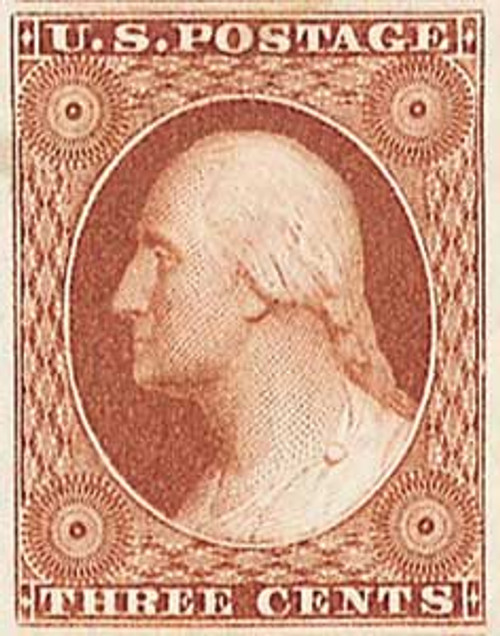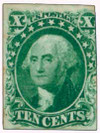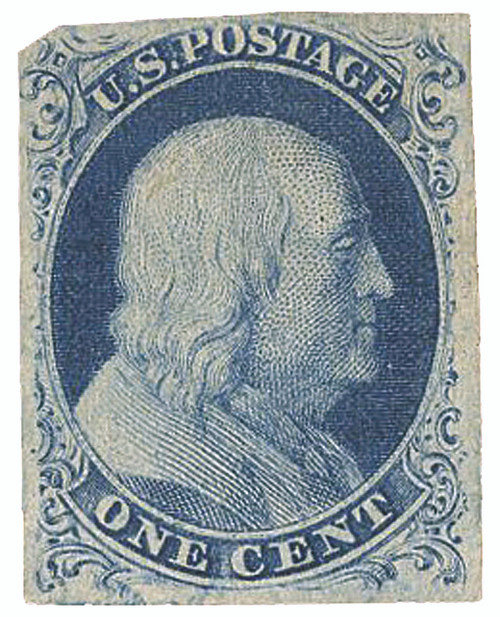
1855 10c Washington, green, imperforate, type III
# 15 - 1855 10c Washington, green, imperforate, type III
$195.00 - $2,500.00
U.S. #15
1855 Washington, Type III
- Main usage for letters going to and from California
Stamp Category: Definitive
Series: 1851-57 Issue
Value: 10c
Earliest Known Use: May 19, 1855
Printed by: Toppan, Carpenter, Casilear & Co.
Quantity printed: 2,000,000 (estimate)
Format: Printed in sheets of 200 stamps, divided into panes of 100 each
Printing Method: Engraving
Perforations: Imperforate
Color: Green
Why the stamp was issued: In April, 1855, by Act of Congress, the domestic letter rate for letters weighing up to one-half ounce and traveling over 3000 miles, was increased to 10c. The 10c Washington stamp was issued to satisfy that rate. Many of the stamps were used to frank letters going and from to California.
About the printing: The design is engraved on a die – a small, flat piece of steel. The design is copied to a transfer roll – a blank roll of steel. Several impressions or “reliefs” are made on the roll. The reliefs are transferred to the plate – a large, flat piece of steel from which the stamps are printed.
Types or “varieties” occur when a stamp has differences which vary from the way it was originally engraved. Foreign matter, or damage to or recutting of the plate, can cause these differences to show up on the stamps printed from it. Color varieties may also be created when a change is made to the printing ink. There were several types created by changes to the printing plates of the 10c Washington.
About the design: George Washington’s portrait was based on a painting by Gilbert Suart who painted many portraits of the first president. Thirteen white stars, symbolizing the 13 original US colonies, form an arch over Washington’s head in the stamp’s medallion.
Special Design Details: US #15 is Type III. The outer line over the top label and both X numerals is broken. The bottom outer line and shells on both left and right are partly cut away. Side ornaments are complete, as are the three side pearls on both outer edges, the same as on types I, II and IV.
About the 1851-57 Series: On July 1, 1851, 1c, 3c, and 12c stamps were issued. These new stamps met the reduced postal rates passed by act of Congress on March 3, 1851. U.S. #1 and #2 were demonetized. Later reductions due to the Act of March 3, 1855 led to 10c (1855) and 5c (1856) additions to the series. Perforated stamps of the same designs (plus three new designs) were issued in 1857.
History the stamp represents: America’s first two postage stamps were issued in 1847. Rates were determined by the weight and distance the letter was mailed. Letters mailed 300 miles or less were 5¢ per half ounce; while those mailed over 300 miles were 10¢ per half ounce. Postage could be paid by the sender at the time the letter was mailed, or by the addressee upon receipt.
US#1 and #2 and the fees they paid remained in use until 1851, when Congress reduced postal rates. These new rates created the need for new denominations. The first stamps issued to meet the lower rates were issued on July 1, 1851. The new 1¢ stamp was used on newspapers, circulars, and “drop letters” (letters mailed to the same town.) The single letter rate, based on a half-ounce, was changed to 3¢ for mail sent up to and including 3,000 miles (except for drop letters.) Mail exceeding this distance was lowered to 6¢ and two of the new 3c stamps could be used to pay postage to the West Coast. Besides the 1c and 3c stamps, a 12c stamp was issued.
An Act of Congress on March 3rd, 1855 made the pre-payment of postage mandatory as of April 1st, 1855. And prepayment with stamps, mandatory as of January 1st, 1856. Requiring people to use stamps lightened the burden on postal clerks and allowed mailers to simply drop their letters in the post office mail slot, rather than waiting in long lines. The rate for any single letter going anywhere under 3,000 miles was 3c per half ounce. As mentioned above, the cost to mail a letter going 3000 miles (or more) was increased to 10c by this act.
U.S. #15
1855 Washington, Type III
- Main usage for letters going to and from California
Stamp Category: Definitive
Series: 1851-57 Issue
Value: 10c
Earliest Known Use: May 19, 1855
Printed by: Toppan, Carpenter, Casilear & Co.
Quantity printed: 2,000,000 (estimate)
Format: Printed in sheets of 200 stamps, divided into panes of 100 each
Printing Method: Engraving
Perforations: Imperforate
Color: Green
Why the stamp was issued: In April, 1855, by Act of Congress, the domestic letter rate for letters weighing up to one-half ounce and traveling over 3000 miles, was increased to 10c. The 10c Washington stamp was issued to satisfy that rate. Many of the stamps were used to frank letters going and from to California.
About the printing: The design is engraved on a die – a small, flat piece of steel. The design is copied to a transfer roll – a blank roll of steel. Several impressions or “reliefs” are made on the roll. The reliefs are transferred to the plate – a large, flat piece of steel from which the stamps are printed.
Types or “varieties” occur when a stamp has differences which vary from the way it was originally engraved. Foreign matter, or damage to or recutting of the plate, can cause these differences to show up on the stamps printed from it. Color varieties may also be created when a change is made to the printing ink. There were several types created by changes to the printing plates of the 10c Washington.
About the design: George Washington’s portrait was based on a painting by Gilbert Suart who painted many portraits of the first president. Thirteen white stars, symbolizing the 13 original US colonies, form an arch over Washington’s head in the stamp’s medallion.
Special Design Details: US #15 is Type III. The outer line over the top label and both X numerals is broken. The bottom outer line and shells on both left and right are partly cut away. Side ornaments are complete, as are the three side pearls on both outer edges, the same as on types I, II and IV.
About the 1851-57 Series: On July 1, 1851, 1c, 3c, and 12c stamps were issued. These new stamps met the reduced postal rates passed by act of Congress on March 3, 1851. U.S. #1 and #2 were demonetized. Later reductions due to the Act of March 3, 1855 led to 10c (1855) and 5c (1856) additions to the series. Perforated stamps of the same designs (plus three new designs) were issued in 1857.
History the stamp represents: America’s first two postage stamps were issued in 1847. Rates were determined by the weight and distance the letter was mailed. Letters mailed 300 miles or less were 5¢ per half ounce; while those mailed over 300 miles were 10¢ per half ounce. Postage could be paid by the sender at the time the letter was mailed, or by the addressee upon receipt.
US#1 and #2 and the fees they paid remained in use until 1851, when Congress reduced postal rates. These new rates created the need for new denominations. The first stamps issued to meet the lower rates were issued on July 1, 1851. The new 1¢ stamp was used on newspapers, circulars, and “drop letters” (letters mailed to the same town.) The single letter rate, based on a half-ounce, was changed to 3¢ for mail sent up to and including 3,000 miles (except for drop letters.) Mail exceeding this distance was lowered to 6¢ and two of the new 3c stamps could be used to pay postage to the West Coast. Besides the 1c and 3c stamps, a 12c stamp was issued.
An Act of Congress on March 3rd, 1855 made the pre-payment of postage mandatory as of April 1st, 1855. And prepayment with stamps, mandatory as of January 1st, 1856. Requiring people to use stamps lightened the burden on postal clerks and allowed mailers to simply drop their letters in the post office mail slot, rather than waiting in long lines. The rate for any single letter going anywhere under 3,000 miles was 3c per half ounce. As mentioned above, the cost to mail a letter going 3000 miles (or more) was increased to 10c by this act.

















